

Ranka (legend) Ranka (爛柯) or Lankeshan ji, or Rotten Axe Handle in English, is a Chinese legend similar to that of Rip Van Winkle, although it predates it by at least a 1000 years.
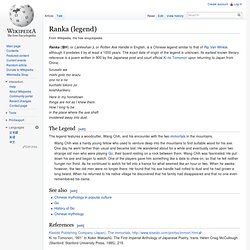
The exact date of origin of the legend is unknown. Its earliest known literary reference is a poem written in 900 by the Japanese poet and court official Ki no Tomonori upon returning to Japan from China: furusato wamishi goto mo arazuono no e nokuchishi tokoro zokoishikarikeru Here in my hometownthings are not as I knew them.How I long to bein the place where the axe shaftmoldered away into dust.
Wall Photos. Spiritual Development. Facebook. Irish mythology. Bunworth Banshee The mythology of pre-Christian Ireland did not entirely survive the conversion to Christianity.
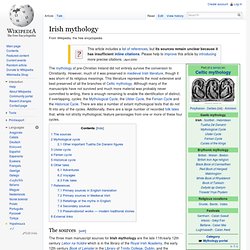
Mag Mell. In Irish mythology, Mag Mell (modern spelling: Magh Meall, meaning "plain of joy") was a mythical realm achievable through death and/or glory.

Unlike the underworld in some mythologies, Mag Mell was a pleasurable paradise, identified as either an island far to the west of Ireland or a kingdom beneath the ocean. However, Mag Mell was similar to the fields of Elysium in Greek mythology, and like the fields of Elysium, was accessible only to a select few. Furthermore, Mag Mell, like the numerous other mystical islands said to be off the coast of Ireland, was never explicitly stated in any surviving mythological account to be an afterlife.
Rather, it is usually portrayed as a paradisal location populated by deities, which is occasionally visited by some adventurous mortals. In its island guise it was visited by various Irish heroes and monks forming the basis of the Adventure Myth or "echtrae" as defined by Myles Dillon in his book Early Irish Literature. See also[edit] Tír na nÓg. In Irish mythology and folklore, Tír na nÓg ([tʲiːɾˠ n̪ˠə ˈn̪ˠoːɡ]; "Land of the Young") or Tír na hÓige ("Land of Youth") is one of the names for the Otherworld, or perhaps for a part of it.
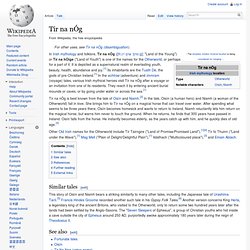
It is depicted as a supernatural realm of everlasting youth, beauty, health, abundance and joy.[1] Its inhabitants are the Tuath Dé, the gods of pre-Christian Ireland.[1] In the echtrae (adventure) and immram (voyage) tales, various Irish mythical heroes visit Tír na nÓg after a voyage or an invitation from one of its residents. They reach it by entering ancient burial mounds or caves, or by going under water or across the sea.[1] Other Old Irish names for the Otherworld include Tír Tairngire ("Land of Promise/Promised Land"),[1][4] Tír fo Thuinn ("Land under the Wave"),[1] Mag Mell ("Plain of Delight/Delightful Plain"),[1] Ildathach ("Multicoloured place"),[3] and Emain Ablach. Similar tales[edit] See also[edit] References[edit] Tuatha Dé Danann. Much of Irish mythology was recorded by Christian monks, who modified it to an extent.
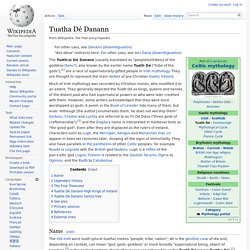
They generally depicted the Tuath Dé as kings, queens and heroes of the distant past who had supernatural powers or who were later credited with them. However, some writers acknowledged that they were once worshipped as gods. A poem in the Book of Leinster lists many of them, but ends "Although [the author] enumerates them, he does not worship them". Goibniu, Credne and Luchta are referred to as Trí Dé Dána ("three gods of craftsmanship"),[2] and the Dagda's name is interpreted in medieval texts as "the good god". Otherworld. The concept of an "otherworld" in historical Indo-European religion is reconstructed in comparative mythology.
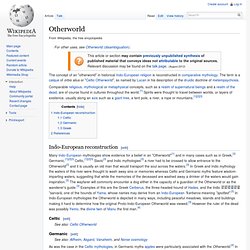
The term is a calque of orbis alius or "Celtic Otherworld", so named by Lucan in his description of the druidic doctrine of metempsychosis. Comparable religious, mythological or metaphysical concepts, such as a realm of supernatural beings and a realm of the dead, are of course found in cultures throughout the world.[1] Spirits were thought to travel between worlds, or layers of existence, usually along an axis such as a giant tree, a tent pole, a river, a rope or mountains.[1][2][3] Indo-European reconstruction[edit] Aos Sí. Some secondary and tertiary sources including well-known and influential authors such as W.B. Yeats refer to aos sí simply as "the sídhe" (lit.: mounds).[1] In Gaelic mythology[edit] In Gaelic folklore[edit] In folk belief and practice, the aos sí are often appeased with offerings, and care is taken to avoid angering or insulting them. Facebook. Egypt. Duat.
Gods and Godesses of Duat. Ancient Egypt. Egyption Gods and Godesses. Curse of the pharaohs. Sphinx. Perhaps the first sphinx, Queen Hetepheres II from the fourth dynasty (Cairo Museum) A sphinx (Greek: Σφίγξ /sphinx/.

Ancient Egyptian religion. Ancient Egyptian religion was a complex system of polytheistic beliefs and rituals which were an integral part of ancient Egyptian society.

It centered on the Egyptians' interaction with many deities who were believed to be present in, and in control of, the forces and elements of nature. The practices of Egyptian religion were efforts to provide for the gods and gain their favor. Our Ancient People. Myths and legends.